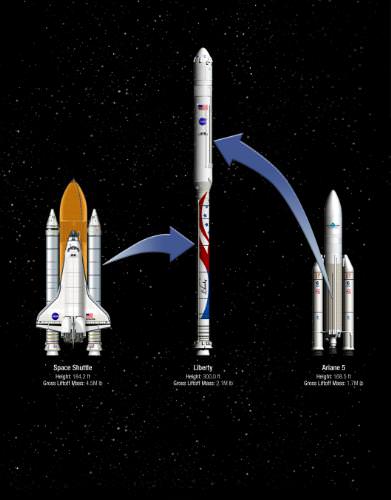[/caption]
An idea too good to die, or a case of recycle, reuse, reduce? Two rocket companies are joining forces to use part of the Ares-1 rocket and combine it with elements of the Ariane 5 launcher to create a new launch system called Liberty that they say will “close the US human spaceflight gap.” US company ATK (Alliant Techsystems) and the European firm Astrium announced their collaboration today on a 90-meter (300-ft) rocket that would fit under NASA’s Commercial Crew Development-2 (CCDev-2) procurement. The companies say the new rocket could be ready by 2013.
“This team represents the true sense of international partnership in that we looked across borders to find the best for our customers,” said Blake Larson, President of ATK Aerospace Systems Group in a press release. “Together we combine unique flight-proven systems and commercial experience that allows us to offer the market’s most capable launch vehicle along with flexibility to meet a wide variety of emerging needs. Liberty provides greater performance at less cost than any other comparable launch vehicle.”
The partners say Liberty would be much cheaper than the Ares I, because the unfinished upper stage of the Ares I would be replaced with the first stage of the Ariane 5, which has been launched successfully 41 consecutive times. The lower stage of the Liberty, a longer version of the shuttle booster built by ATK, would be almost the same as what was built for Ares-1.

Since both stages were designed for human-rating, the collaborators say this “would enable unmatched crew safety.” The team has planned an initial flight by the end of 2013, a second test flight in 2014, and operational capability in 2015.
Liberty would be able to deliver 20,000 kg (44,500 lbs) to the International Space Station’s orbit, which would give it a launch capability to carry any crew vehicle in development. This is less payload capability, however, than the 25-ton payload that the Ares-1 was advertised to deliver to the ISS.
With the announcement of the collaboration (and quick turn-around) the companies are hoping to be the recipient of some of the $200 million in funding NASA is planning to give out in March 2011 to private companies that are developing space taxis. Smaller NewSpace companies like SpaceX and , Orbital, along with big companies Lockheed Martin and Boeing are all vying for the CCDev-2 contracts.
With some space experts and Congress expressing concern about the length of time it might take for commercial companies to provide reliable transportation to space, as well as concerns about relying on the Russian Soyuz vehicles, this new collaboration could fit NASA’s needs nicely. Plus, the collaborators are hoping the new Liberty rocket will be a bargain compared to other contenders. They are targeting a price of $180 million per launch, which is slightly less than the Atlas V rocket launches by the Boeing-Lockheed Martin United Launch Alliance, ($187 million).
The two companies have touted the new rockets’ ability to carry a wide array of spacecraft and satellites.
“The Liberty initiative provides tremendous value because it builds on European Ariane 5 launcher heritage, while allowing NASA to leverage the mature first stage,” said former NASA astronaut Charlie Precourt, Vice President and General Manager of ATK Space Launch Systems. “We will provide unmatched payload performance at a fraction of the cost, and we will launch it from the Kennedy Space Center using facilities that have already been built. This approach allows NASA to utilize the investments that have already been made in our nation’s ground infrastructure and propulsion systems for the Space Exploration Program.”
If NASA chooses the Liberty system and it works well, it could mean that the money NASA spent on the Ares rocket was not wasted after all.
ATK has put together this video about “Liberty”
Source: ATK

